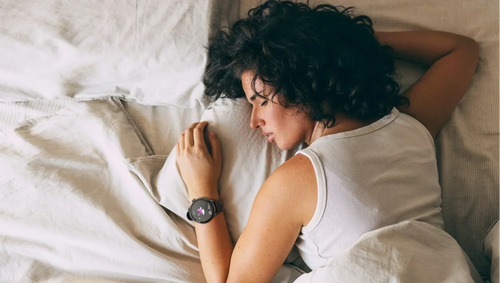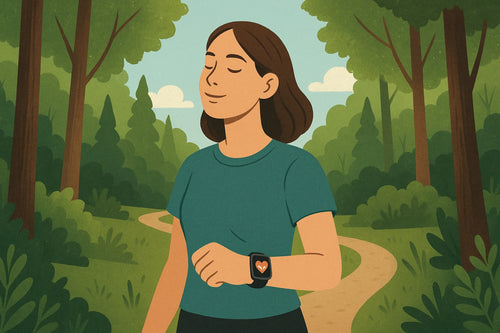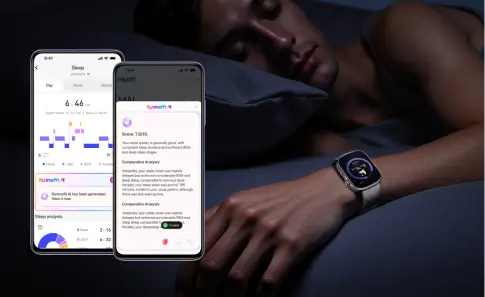When's the Best Time to Nap and How Long Should It Last

Key Takeaway
- Aim for early afternoon naps (1–3 PM) to align with your body's natural energy dip.
- Keep your naps between 10–30 minutes to avoid grogginess.
- You don't have to fall fully asleep—resting quietly can still help.
- Use tools like the Runmefit smartwatch to track and improve your nap habits.
- Longer naps (60–90 minutes) can be helpful but may affect nighttime sleep.
- Napping can boost your energy, improve focus, and help you feel more refreshed—if done right. Aim for early afternoon naps between 10 to 30 minutes for the best results.
What Is a Nap?
A nap is a short period of sleep taken during the day, typically lasting anywhere from 10 minutes to 90 minutes.
Unlike a full night's sleep, naps are meant to provide a quick recharge—boosting alertness, mood, and mental clarity. People nap for different reasons: to make up for lost sleep, to improve concentration, or simply because their body feels the need to rest. While naps aren't a replacement for good nighttime sleep, they can be a helpful addition to your daily routine.
How Do Smartwatches Detect Naps?
Smartwatches like the Runmefit fitness tracker can automatically detect when you nap. They do this by tracking changes in your heart rate and movement. When your body stays still and your heart rate drops, the watch knows you might be asleep. It uses this data to log how long you napped and how restful it was, helping you see how naps affect your energy and sleep patterns.
If you have a Runmefit watch, managing naps is even easier. It not only detects naps, but also lets you set alarms just for naps. This is useful if you're trying to nap regularly during the day.
After recording your sleep throughout the day, the watch will give you a sleep report. You'll see how long you slept and details for your sleep stages and nap. The Runmefit app also uses AI to give you deeper insights. It shows how your nap fits into your overall sleep health and helps you build better habits.
Want to make the most of your nap with Runmefit? Here are a few tips:
- Before your nap, use the watch's timer or nap alarm feature to avoid oversleeping.
- Review your nap stats afterward to see how rested you really feel. Over time, you'll spot patterns and know what nap length suits you best.
What Are the Benefits of Naps?
A short nap can do wonders. It boosts your mood, clears your mind, and sharpens your memory. If you didn't sleep well at night, a nap can help you feel more alert during the day. It's like a mini reset for your brain.
Research shows that naps can enhance learning, reduce stress, and improve emotional regulation. For students, naps can help lock in new information. For workers, a quick rest can restore mental clarity and productivity. Even athletes use naps to recharge and recover between training sessions.
Plus, a nap can help balance your overall sleep needs. If you had a rough night or woke up early, a short nap fills in the gaps and keeps your energy stable through the day.
Do I Really Need a Nap?
Not everyone needs a nap every day. But if you feel constantly tired, have trouble concentrating, or find yourself yawning nonstop, your body might be telling you it needs rest. A nap can give your brain and body a short break to recharge.
Napping is especially useful on days when you're feeling stressed or didn't sleep well the night before. Instead of reaching for another coffee, take a short rest. It's more restorative and won't keep you up later like caffeine can.
Still, naps aren't for everyone. Some people function perfectly without them. The key is to listen to your body and figure out what works for you. Even just 10 minutes of rest can help some people feel more alert and refreshed.
When Should You Nap?

Your body has a natural dip in energy in the early afternoon, usually between 1 and 3 PM. This period is often called the "afternoon slump." It's when most people feel less alert and a bit sleepy. That's why it's considered the best time for a nap.
This dip in alertness is part of your circadian rhythm—the internal clock that controls your sleep and wake cycles. Taking a nap during this low-energy period helps you recharge without interfering with your nighttime sleep.
If you nap too late, especially in the early evening, it can make it harder to fall asleep at night. That's why timing is important. Stick to the early afternoon for the most benefit.
If you work from home or have a flexible job, the early afternoon window is your best chance to take a short nap. Even just 15 minutes can lift your mood and sharpen your focus. But if you're a shift worker or have an night owls, your ideal nap time might be different. The most important thing is to find a quiet, safe place to rest when you feel tired.
Do You Really Need to Fall Asleep During Your Nap?
Not necessarily. You can still get benefits from simply resting. Lying down in a quiet place with your eyes closed can help relax your mind and body, even if you don’t fully fall asleep.
These short breaks are sometimes called "restorative rests." During this time, even you didn't fall asleep, your heart rate slows, your breathing deepens, and your muscles relax. It gives your brain a pause, which can be just as valuable as sleep.
If you're wearing a smartwatch like Runmefit, it can track these restful periods. It may show that you entered light sleep, even if you didn’t feel like you did. Over time, this can help you see how consistent rest—whether it’s sleep or not—improves your energy levels.
How Long Should It Last?
The length of your nap affects what you get out of it. Here's a simple breakdown:
- 10–20 minutes: Great for a quick boost. You'll feel more alert and focused without feeling groggy.
- 30 minutes: You might wake up during a deeper sleep stage, which can leave you feeling foggy.
- 60 minutes: Helps with memory and problem-solving, but you may feel disoriented when you wake up.
- 90 minutes: A full sleep cycle. This improves creativity, emotional balance, and learning. You'll usually wake up feeling refreshed.
Shorter naps are like having a quick snack. They boost your energy fast. Longer naps are more like a full meal. They take more time but offer deeper recovery.
Napping Times for Different Age Groups
Not everyone needs the same amount of nap time. Here's a quick guide to average nap needs by age:
|
Age Group |
Recommended Nap Duration |
Notes |
|
Infants (0–1 year) |
2–4 naps, 30–120 mins |
Essential for growth and brain development |
|
Toddlers (1–3 years) |
1–2 naps, 60–90 mins |
Supports memory and behavior |
|
Preschoolers (3–5) |
1 nap, 45–60 mins |
Still helpful but may start to fade |
|
Kids (6–12 years) |
Occasional, 30–45 mins |
Usually only needed after poor sleep |
|
Teens (13–17 years) |
Optional, 20–30 mins |
Useful for catching up on rest |
|
Adults (18–64 years) |
Optional, 10–30 mins |
Ideal for boosting focus and mood |
|
Seniors (65+) |
Optional, 20–40 mins |
Can support alertness and memory |
Everyone is different. Some people nap daily, while others rarely do. Use these as a guideline and adjust based on how you feel. If you're not sure what works best, tools like the Runmefit smartwatch can help you spot your natural rhythms and ideal nap length.
What Are the Drawbacks of Napping?
Naps can be refreshing, but they aren't always helpful. Naps can backfire if you overdo them and even mess up your night sleep. Also, needing naps too often might be a sign that your nighttime sleep isn't good enough.
What If It's Too Short?
If your nap is too short, it might not seem helpful. Some people need more time to get real benefits.
However, even a 10-minute rest can improve focus and mood, especially in a quiet, relaxing space. If you're using a Runmefit smartwatch, it can help you detect when your nap time and figure out if shorter naps work for you or if you need a bit longer.
What If It's Too Long?
Napping too long, especially over 90 minutes, can lead to something called sleep inertia. This happens when you wake up from deep sleep and your brain feels foggy. Long or late naps can also make it harder to fall asleep at night.
To avoid this, keep your nap between 10 and 30 minutes and try to nap in the early afternoon. A Runmefit watch can help you stick to this window by setting alarms and tracking how different nap lengths affect your energy.
If you frequently feel like taking naps during the day, it might be a signal poor nighttime sleep or insufficient deep sleep at night. You can start tracking your full sleep habits at night witha sleep tarcker like Runmeift WATCH 4. It can track both night and day sleep to give you a clear picture of your rest patterns, and you can track your long-term sleep trends.
What Affects Your Nap?
Several things can mess with your nap quality:
- Bright lights or noise
- Room too hot or too cold
- Caffeine too close to nap time
- Stress or racing thoughts
Your environment plays a huge role. Try napping in a quiet, dim space. If that's not possible, earplugs, an eye mask, or white noise can help.
Runmefit users can benefit from tracking nap trends in the app. If you often wake up feeling groggy, check the sleep quality graph. You might find that room temperature or noise affected your rest more than you thought.
Tips for the Perfect Power Nap
- Nap in early afternoon.
- Keep it short: 10–30 minutes is ideal.
- Make your space quiet and dark.
- Use a sleep mask or white noise if needed.
- Set an alarm to avoid oversleeping.
- Wind down with deep breaths or calm music before you nap.
If you have a Runmefit smartwatch, let it guide you. Check your stats, find your ideal nap window, and track what works best. Also, create a nap routine. Just like bedtime habits, a few small rituals can cue your body that it's time to rest. Maybe that's turning off your phone, sipping water, or closing your eyes with gentle music.
Remember: naps aren't about laziness. They're a smart way to manage your energy and take better care of your mind and body.
Recent News

When's the Best Time to Nap and How Long Should It Last

How Nature Calms Your Mind — and How Smartwatches Can Help You Feel It

